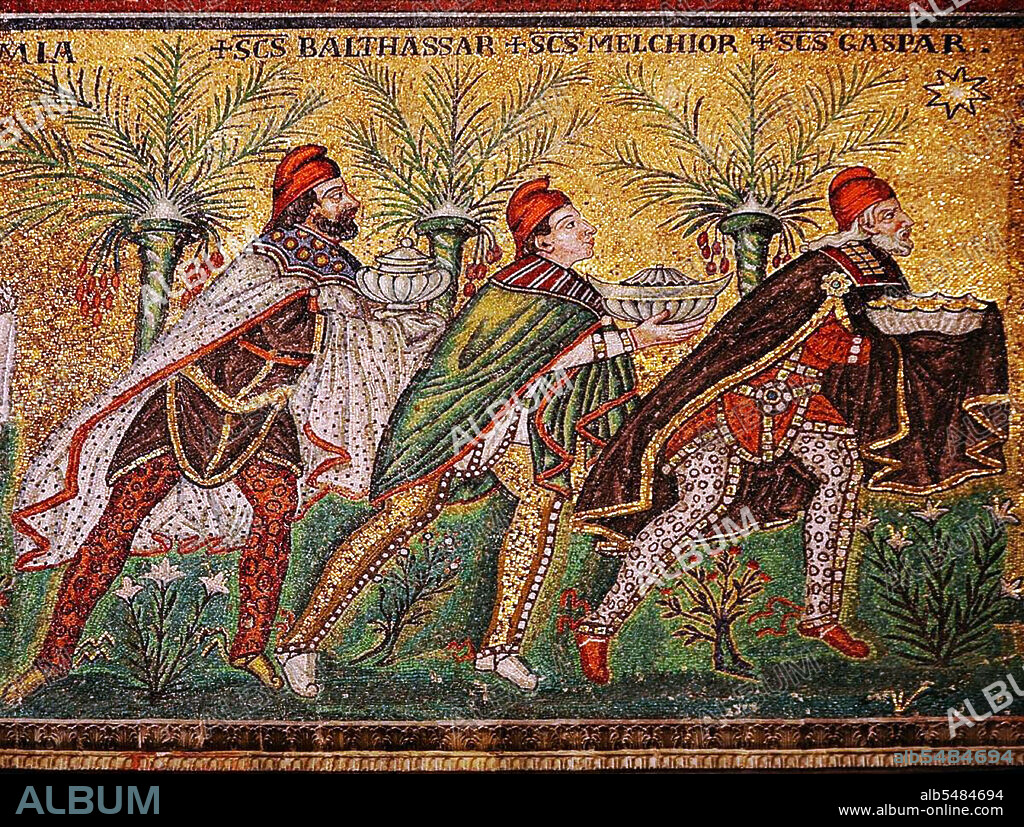alb5484694
The Magi represented in Persian dress in a mosaic at the Basilica of Sant'Apollinare Nuovo, Ravenna,7th century CE.

|
Zu einem anderen Lightbox hinzufügen |
|
Zu einem anderen Lightbox hinzufügen |



Haben Sie bereits ein Konto? Anmelden
Sie haben kein Konto? Registrieren
Dieses Bild kaufen.
Nutzung auswählen:

Titel:
The Magi represented in Persian dress in a mosaic at the Basilica of Sant'Apollinare Nuovo, Ravenna,7th century CE.
Untertitel:
Siehe automatische Übersetzung
Magi (English singular magian, mage, magus, magusian, magusaean) is a term, used since at least the 4th century BCE, to denote followers of Zoroaster, or rather, followers of what the Hellenistic world associated Zoroaster with, which was in the main the ability to read the stars, and manipulate the fate that the stars foretold. Pervasive throughout the Eastern Mediterranean and Western Asia until late antiquity and beyond, Greek magos, 'Magian' or 'magician,' was influenced by (and eventually displaced) Greek goas, the older word for a practitioner of magic, to include astrology, alchemy and other forms of esoteric knowledge. This association was in turn the product of the Hellenistic fascination for (Pseudo-) Zoroaster, who was perceived by the Greeks to be the 'Chaldean' 'founder' of the Magi and 'inventor' of both astrology and magic. Among the skeptical thinkers of the period, the term 'magian' acquired a negative connotation and was associated with tricksters and conjurers. This pejorative meaning survives in the words 'magic' and 'magician'. In English, the term 'magi' is most commonly used in reference to the Gospel of Matthew's 'wise men from the East', or 'three wise men', though that number does not actually appear in Matthew's account. The plural 'magi' entered the English language around 1200, in reference to the Biblical magi of Matthew 2:1. The singular appears considerably later, in the late 14th century, when it was borrowed from Old French in the meaning magician together with magic.
Bildnachweis:
Album / Pictures From History/Universal Images Group
Freigaben (Releases):
Model: Nein - Eigentum: Nein
Rechtefragen?
Rechtefragen?
Bildgröße:
4800 x 3627 px | 49.8 MB
Druckgröße:
40.6 x 30.7 cm | 16.0 x 12.1 in (300 dpi)
Schlüsselwörter:
ANBETUNG DER KOENIGE • ANBETUNG DER KÖNIGE • ARABIEN • ASIEN • ASIEN, KONTINENT • BIBEL NT: HL. DREI KOENIGE • BIBEL • BYZANTINISCH • CHRISTENTUM • DREI HEILIGE KOENIGE • DREIKOENIGSFEST • DREIKÖNIGE • EPIPHANIE • GESCHICHTE • GOLD • HEILIGE DREI KOENIGE (EPIPHANIAS) • HEILIGE DREI KOENIGE (NEUES TESTAMENT) • HEILIGE DREI KONIGE (EPIPHANIAS) • HEILIGE DREI KÖNIGE (EPIPHANIAS) • HEILIGE DREI KÖNIGE (NEUES TESTAMENT) • HEILIGE DREI KÖNIGE (NEÜS TESTAMENT) • HL. DREI KOENIGE • HL. DREI KOENIGE, BIBEL NT • IRAN • ISRAEL • ITALIEN • KONTINENT, ASIEN • KUNST • MOSAIK • MYTHEN: PERSISCH • PERSISCH • PERSISCHE MYTHEN • PERSISCHE • RELIGION • ZEITGESCHICHTE
 Pinterest
Pinterest Twitter
Twitter Facebook
Facebook Link kopieren
Link kopieren Email
Email
